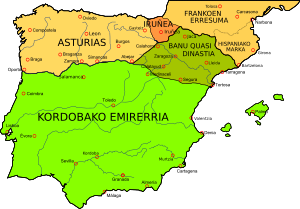Onneca Fortúnez facts for kids
Quick facts for kids Onneca / Iñiga |
|||||
|---|---|---|---|---|---|
| Infanta of Pamplona | |||||
| Born | 848/850 | ||||
| Died | aft. 890 | ||||
| Spouse | Abdullah of Córdoba (m. 862/863) Aznar Sánchez de Laron (m. 882/883) |
||||
| Issue | Muhammad al-Baha' Fatima the Younger Sancho Toda, Queen of Pamplona Sancha, Queen of Pamplona |
||||
|
|||||
| House | House of Íñiguez | ||||
| Father | Fortún Garcés of Pamplona | ||||
| Mother | Auria | ||||
Onneca Fortúnez or Iñiga Fortúnez (born around 848 – died after 890) was a princess from the Basque land of Pamplona. This area is now known as Navarre in Spain. She was the daughter of Fortún Garcés of Pamplona and his wife Auria.
When Onneca was born, much of the Iberian Peninsula (modern-day Spain and Portugal) was ruled by the Muslim Umayyad dynasty. Only the northern kingdoms, like Asturias, Pamplona, and some areas in the Pyrenees mountains, were still controlled by Christian rulers. Onneca belonged to the Íñiguez family. This family was named after her great-grandfather, Íñigo Arista, who started the Kingdom of Pamplona.
We don't have a lot of information about Onneca's life. What we know comes from an old book called the Códice de Roda. We also learn about her from Muslim historians in Al-Andalus (Muslim Spain). They called her Durr (در), which means "pearl" in Arabic.
Onneca's marriages helped connect the Christian and Muslim royal families in the Iberian Peninsula. This led to important cooperation between the Christian Íñiguez family and the Muslim Umayyads. The effects of her marriages were felt for a long time, even after she died.
Contents
Marriage to Emir Abdullah

In 860, Onneca's father, Fortún Garcés, was the heir to the throne of Pamplona. He was captured in the town of Milagro. This happened during a military attack led by Muhammad I, the Muslim ruler (emir) of Córdoba.
Muhammad I's army attacked Pamplona, destroying parts of the kingdom and taking three castles. Fortún Garcés, who was called al-Anqar (meaning "the one-eyed") by the Muslims, was taken to Córdoba. He was held there for 20 years, living comfortably but unable to leave.
We don't know if Onneca was captured with her father or if she joined him later in Córdoba. But she married Muhammad I's son, Abdullah, around 862 or 863. Onneca was probably still a teenager when she had her first son, Muhammad, in 864. As Abdullah's wife, she became known as Durr. Some historians believe she converted to Islam.
Onneca had two daughters with Abdullah: al-Baha' and Fatima the Younger. Abdullah became emir in 888. Onneca's son, Muhammad, was chosen to be the next ruler. However, Muhammad was killed by his younger half-brother, al-Mutarrif, in 891. Later, al-Mutarrif was also killed by his father, Abdullah.
Because of this, Muhammad's son, Abd-ar-Rahman III, became the next emir after his grandfather Abdullah. Abd-ar-Rahman III was born just three weeks before his father was killed. He later became a powerful ruler known as a caliph.
Onneca was the grandmother of Abd-ar-Rahman III. He inherited some of her European features, like blue eyes and light reddish hair. He even tried to change his hair color to look more like a typical Arab.
Return to Pamplona and Second Marriage
An old book, the Códice de Roda, says that Onneca married her cousin Aznar Sánchez de Laron before she married Abdullah. But this causes problems with the timeline of her children's births. If that were true, her daughter Toda would have been very old when her own son was born.
Most historians now believe the Códice de Roda made a mistake in the order of her marriages. They think Onneca returned to Pamplona with her father around 880, after being in Córdoba for 20 years. After returning, she then married Aznar Sánchez de Laron.
With Aznar Sánchez, Onneca had a son named Sancho and two daughters, Toda and Sancha. They were likely born between 880 and 890. Her son Sancho Aznar is only mentioned in the Códice de Roda and might have died young.
Onneca's daughters, Toda and Sancha, both became queens of Pamplona. They married into the Jiménez dynasty, which took power in 905. Toda married Sancho I Garcés. This marriage helped to unite the Íñiguez and Jiménez royal families. Sancha married Sancho I Garcés's brother, Jimeno Garcés.
Onneca's Importance
Onneca is important in history because she created a special family link. She connected the Muslim caliphs of Córdoba with the Christian kings of Pamplona. She also linked the first two royal dynasties of Pamplona.
Family tree
This family tree shows how Onneca was related to her close family. Solid lines show children, and dashed lines show marriages. The names of the three main families Onneca was connected to are in big letters. These are the Íñiguez family (her birth family), the Umayyad dynasty (her first husband's family), and the Jiménez dynasty (her daughters' husbands' family).
| Family tree of Onneca Fortúnez | |||||||||||||||||||||||||||||||||||||||||||||||||||||||||||||||||||||||||||||||||||||||||||||||||||||||||||||||||||||||||||||||||||||||||||||||||||||||||||||||||||||||||||||||||||||||||||||||||||||||||||||||||||||||||||||||||||||||||||||||||||||||||||||||||||||||||||||||||||||||||||||||||||||||||||||||||||||||||||||||||||||||||||||||||||||||||||||||||||||||||||||||||||||||||||||||||||||||||||||||||||||||||||||||||||||||||||||||||||||||||||||||||||||||||||||||||||||||||||||||||||||||||||||||||||||||||||||||||||||||||||||||||||||||||||||||||||||||||||||||||||||||||||||||||||||||||||||||||||||||||||||||||||||||||||||||||||||||||||||||||||||||||||||||||||||||||||||||||||||||||||||||||||||||||||||||||||||||||||||||||||||||||||||||||||||||||||||||||||||||||||||||||||||||||||||||||||||||||||||||||||||||||||||||||||||||||||||||||||||||||||||||||||||||||||||||||||||||||||||||||||||||||||||||||||||||||||||||||||||||||||||||||||||||||||||||||||||||||||||||||||||||||||||||||||||||||||||||||||||||
|---|---|---|---|---|---|---|---|---|---|---|---|---|---|---|---|---|---|---|---|---|---|---|---|---|---|---|---|---|---|---|---|---|---|---|---|---|---|---|---|---|---|---|---|---|---|---|---|---|---|---|---|---|---|---|---|---|---|---|---|---|---|---|---|---|---|---|---|---|---|---|---|---|---|---|---|---|---|---|---|---|---|---|---|---|---|---|---|---|---|---|---|---|---|---|---|---|---|---|---|---|---|---|---|---|---|---|---|---|---|---|---|---|---|---|---|---|---|---|---|---|---|---|---|---|---|---|---|---|---|---|---|---|---|---|---|---|---|---|---|---|---|---|---|---|---|---|---|---|---|---|---|---|---|---|---|---|---|---|---|---|---|---|---|---|---|---|---|---|---|---|---|---|---|---|---|---|---|---|---|---|---|---|---|---|---|---|---|---|---|---|---|---|---|---|---|---|---|---|---|---|---|---|---|---|---|---|---|---|---|---|---|---|---|---|---|---|---|---|---|---|---|---|---|---|---|---|---|---|---|---|---|---|---|---|---|---|---|---|---|---|---|---|---|---|---|---|---|---|---|---|---|---|---|---|---|---|---|---|---|---|---|---|---|---|---|---|---|---|---|---|---|---|---|---|---|---|---|---|---|---|---|---|---|---|---|---|---|---|---|---|---|---|---|---|---|---|---|---|---|---|---|---|---|---|---|---|---|---|---|---|---|---|---|---|---|---|---|---|---|---|---|---|---|---|---|---|---|---|---|---|---|---|---|---|---|---|---|---|---|---|---|---|---|---|---|---|---|---|---|---|---|---|---|---|---|---|---|---|---|---|---|---|---|---|---|---|---|---|---|---|---|---|---|---|---|---|---|---|---|---|---|---|---|---|---|---|---|---|---|---|---|---|---|---|---|---|---|---|---|---|---|---|---|---|---|---|---|---|---|---|---|---|---|---|---|---|---|---|---|---|---|---|---|---|---|---|---|---|---|---|---|---|---|---|---|---|---|---|---|---|---|---|---|---|---|---|---|---|---|---|---|---|---|---|---|---|---|---|---|---|---|---|---|---|---|---|---|---|---|---|---|---|---|---|---|---|---|---|---|---|---|---|---|---|---|---|---|---|---|---|---|---|---|---|---|---|---|---|---|---|---|---|---|---|---|---|---|---|---|---|---|---|---|---|---|---|---|---|---|---|---|---|---|---|---|---|---|---|---|---|---|---|---|---|---|---|---|---|---|---|---|---|---|---|---|---|---|---|---|---|---|---|---|---|---|---|---|---|---|---|---|---|---|---|---|---|---|---|---|---|---|---|---|---|---|---|---|---|---|---|---|---|---|---|---|---|---|---|---|---|---|---|---|---|---|---|---|---|---|---|---|---|---|---|---|---|---|---|---|---|---|---|---|---|---|---|---|---|---|---|---|---|---|---|---|---|---|---|---|---|---|---|---|---|---|---|---|---|---|---|---|---|---|---|---|---|---|---|---|---|---|---|---|---|---|---|---|---|---|---|---|---|---|---|---|---|---|---|---|---|---|---|---|---|---|---|---|---|---|---|---|---|---|---|---|---|---|---|---|---|---|---|---|---|---|---|---|---|---|---|---|---|---|---|---|---|---|---|---|---|---|---|---|---|---|---|---|---|---|---|---|---|---|---|---|---|---|---|---|---|---|---|---|---|---|---|---|---|---|---|---|---|---|---|---|---|---|---|---|---|---|---|---|---|---|---|---|---|---|---|---|---|---|---|---|---|---|---|---|---|---|---|---|---|---|---|---|---|---|---|---|---|---|---|---|---|---|---|---|---|---|---|---|---|---|---|---|---|---|---|---|---|---|---|---|---|---|---|---|---|---|---|---|---|---|---|---|---|---|---|---|---|---|---|---|---|---|---|---|---|---|---|---|---|---|---|---|---|---|---|---|---|---|---|---|---|---|---|---|---|---|---|---|---|---|---|---|---|---|---|---|---|---|---|---|---|---|---|---|---|---|---|---|---|---|---|---|---|---|---|---|---|---|---|---|---|---|---|---|---|---|---|---|---|---|---|---|---|---|---|---|---|---|---|---|---|---|---|---|---|---|---|---|---|---|---|---|---|---|---|---|---|---|---|---|---|---|---|---|---|---|---|---|---|---|---|---|---|---|---|---|---|---|---|---|---|---|---|---|---|---|---|---|---|---|---|---|---|---|---|---|---|---|---|---|---|---|---|---|---|---|---|---|---|---|---|---|---|---|---|---|---|---|---|---|---|---|---|---|---|---|---|---|---|---|---|---|---|---|
|
|||||||||||||||||||||||||||||||||||||||||||||||||||||||||||||||||||||||||||||||||||||||||||||||||||||||||||||||||||||||||||||||||||||||||||||||||||||||||||||||||||||||||||||||||||||||||||||||||||||||||||||||||||||||||||||||||||||||||||||||||||||||||||||||||||||||||||||||||||||||||||||||||||||||||||||||||||||||||||||||||||||||||||||||||||||||||||||||||||||||||||||||||||||||||||||||||||||||||||||||||||||||||||||||||||||||||||||||||||||||||||||||||||||||||||||||||||||||||||||||||||||||||||||||||||||||||||||||||||||||||||||||||||||||||||||||||||||||||||||||||||||||||||||||||||||||||||||||||||||||||||||||||||||||||||||||||||||||||||||||||||||||||||||||||||||||||||||||||||||||||||||||||||||||||||||||||||||||||||||||||||||||||||||||||||||||||||||||||||||||||||||||||||||||||||||||||||||||||||||||||||||||||||||||||||||||||||||||||||||||||||||||||||||||||||||||||||||||||||||||||||||||||||||||||||||||||||||||||||||||||||||||||||||||||||||||||||||||||||||||||||||||||||||||||||||||||||||||||||||||
See also
 In Spanish: Onneca Fortúnez de Pamplona para niños
In Spanish: Onneca Fortúnez de Pamplona para niños
- Family tree of Navarrese monarchs
- List of Navarrese consorts
- List of Navarrese monarchs

